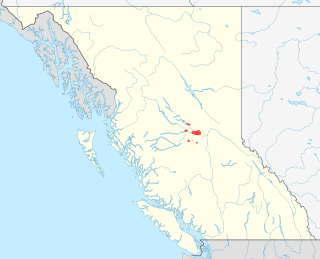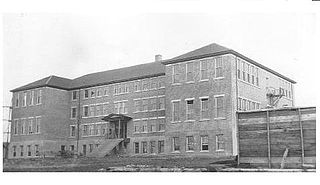Related Research Articles

Athabaskan is a large family of indigenous languages of North America, located in western North America in three areal language groups: Northern, Pacific Coast and Southern. Kari and Potter (2010:10) place the total territory of the 53 Athabaskan languages at 4,022,000 square kilometres (1,553,000 sq mi).

The Dakelh or Carrier are the indigenous people of a large portion of the Central Interior of British Columbia, Canada.
Oowekyala, also Ooweekeeno and ’Wuik̓ala in the language itself, is a dialect of Heiltsuk-Oowekyala, a Northern Wakashan language spoken around Rivers Inlet and Owikeno Lake in the Central Coast region of the Canadian province of British Columbia, spoken by the Wuikinuxv, whose government is the Wuikinuxv Nation.
Heiltsuk, Haíłzaqvḷa, also known as Bella Bella and Haihais, is a dialect of the North Wakashan (Kwakiutlan) language Heiltsuk-Oowekyala that is spoken by the Haihai (Xai'xais) and Bella Bella First Nations peoples of the Central Coast region of the Canadian province of British Columbia, around the communities of Bella Bella and Klemtu, British Columbia. Bella Bella is the headquarters of the Heiltsuk Nation government.

The Dakelh (ᑕᗸᒡ) or Carrier language is a Northern Athabaskan language. It is named after the Dakelh people, a First Nations people of the Central Interior of British Columbia, Canada, for whom Carrier has been a common English name derived from French explorers naming of the people. Dakelh people speak two related languages. One, Babine-Witsuwit'en is sometimes referred to as Northern Carrier. The other includes what are sometimes referred to as Central Carrier and Southern Carrier.
Tahltan, Tāłtān, also called Tałtan ẕāke, dah dẕāhge or didene keh is a poorly documented Northern Athabaskan language historically spoken by the Tahltan people who live in northern British Columbia around Telegraph Creek, Dease Lake, and Iskut. Tahltan is a critically endangered language. Several linguists classify Tahltan as a dialect of the same language as Tagish and Kaska.

Stuart Lake, or Nak'albun in the Carrier (Dakelh) language is a lake situated in the Northern Interior of British Columbia, Canada. The town of Fort St. James is situated by the lake near the outlet. Stuart Lake is 66 kilometres (41 mi) long, 10 kilometres (6.2 mi) wide and relatively shallow, with an average depth of 26 metres (85 ft). There are several privately owned islands on Stuart lake.
Mary John Sr. CM was a leader of the Carrier people of the central interior of British Columbia in Canada. She was known as "Mary John Sr." to distinguish her from her daughter-in-law, also named Mary John. She became well known both for her political and social activism and as a role model, a person of enormous integrity, strength, and gentleness.
Babine–Witsuwitʼen or Nadotʼen-Wetʼsuwetʼen is an Athabaskan language spoken in the Central Interior of British Columbia. Its closest relative is Carrier. Because of this linguistic relationship together with political and cultural ties, Babine–Witsuwitʼen is often referred to as Northern Carrier or Western Carrier. Specialist opinion is, however, that it should be considered a separate, though related, language.
The Carrier Sekani Tribal Council is a tribal council representing six First Nations in the Central Interior of British Columbia. It was originally known as the Lakes District Tribal Council. The CSTC was incorporated in 1981 and is a registered non-profit society.

Lejac Residential School was a Canadian residential school in British Columbia that operated from 1922 to 1976 by the Roman Catholic Church under contract with the Government of Canada.

Saik'uz, or Stoney Creek, is a Dakelh nation whose main community is on a reserve 9 km (6 mi) southwest of Vanderhoof, British Columbia along Kenney Dam Road. Saik'uz is a member of the Carrier Sekani Tribal Council.

The Nadleh Whut'en First Nation is a First Nations government of the Dakelh people, whose territory is located in the Central Interior of British Columbia, Canada, around the east end of Fraser Lake. The nation has seven reserves which Crown-Indigenous Relations and Northern Development Canada refer to as IR#1-9.. Until 1990, it was referred to as the Fraser Lake Indian Band.
Heiltsuk-Oowekyala is a Northern Wakashan (Kwakiutlan) language spoken in the Central Coast region of the Canadian province of British Columbia, spoken by the Wuikinuxv (Oweekeno) and Heiltsuk peoples. It has two dialects, Heiltsuk and Oowekyala (Wuikyala), which unlike other Wakashan languages are tonal. It has no traditional name, so the hyphenated construction Heiltsuk-Oowekyala is used by linguists. Ethnologue calls this language "Heiltsuk", with the Bella Bella dialect (Heiltsuk) labelled "Northern Heiltsuk" and the Oowekyala dialect labeled "Southern Heiltsuk".

Carrier or Déné syllabics is a script created by Adrien-Gabriel Morice for the Carrier language. It was inspired by Cree syllabics and is one of the writing systems in the Canadian Aboriginal syllabics Unicode range.
Keyoh is a Dakelh word meaning. It is the principal traditional area of which a certain indigenous corporate family group has customary use, occupancy, governance, stewardship and ownership rights. It is applied to designate areas such as countries and settlements such as towns and a trapline in the non-native sense, that is the area within which a certain person has the right to trap, but the common translation "trapline" is misleading both in that it is not restricted to the right to trap and it is independent of the provincial system of trapline registration. Indeed, one source of disparity between provincially registered traplines and keyoh, is that provincially registered traplines are held by a single individual who for many years had to be male, while keyoh are held corporately, with its hereditary chief also being strongly patrilineal. The hereditary chief of a Keyoh is known as the keyoh-whudachun, Keyoh Holder or noble. The term keyoh is used in reference to Indigenous rights as on the web site of the Maiyoo Keyoh

Bridget Moran, née Drugan, was a Canadian social activist and author in British Columbia. Born in Enniskillen, County Fermanagh, Northern Ireland, shortly after her birth her family emigrated to Success, Saskatchewan, where she grew up.
Chinlac is the site of a former Dakelh (Carrier) village in northeastern British Columbia, Canada. The site is on the west bank of the Stuart River, about 1 kilometre (1 mi) upstream from its junction with the Nechako River. Oral tradition considers it to have been one of the major Carrier settlements. The site is located at a shallow point in the river where a fishing weir could be used to harvest running salmon. Remains of the weir can still be seen from the meadow.
The Yinka Dene Alliance was a coalition of six First Nations from northern British Columbia, organized to prevent the Enbridge Northern Gateway Pipelines being built through their traditional territories. The coalition first comprised the Nadleh Whut'en, Nak'azdli, Takla Lake, Saik'uz and Wet'suwet'en First Nations. The Tl'azt'en First Nation later joined. These bands represented the interests of around 5,000 aboriginals. The alliance was active from 2010 until 2016 when the pipeline project was cancelled. They utilized indigenous, Canadian and international law, and organized various public protests across Canada.
Southern Carrier, Lower Carrier or locally known as Dakelh is an endangered dialect group of the Athabaskan Carrier language of British Columbia, Canada. The dialects belonging to Southern Carrier roughly correspond to those to the south of Fort St. James. The group is divided into two subgroups, Fraser/Nechakoh and Blackwater which are further subdivided into individual dialects.